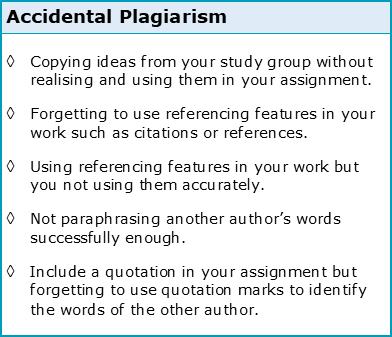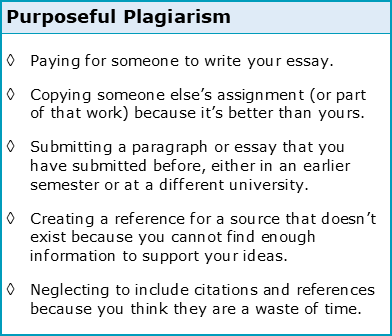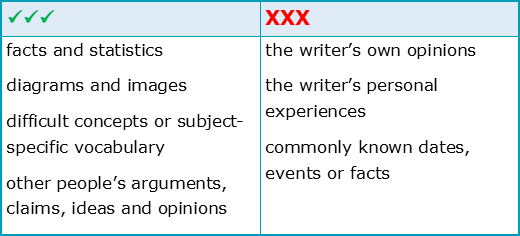Which 7 strategies help students avoid plagiarism?

This is the second and final chapter about Plagiarism Avoidance. To complete this reader, read each chapter carefully and then unlock and complete our materials to check your understanding.
– Review the concept of plagiarism as academic misconduct
– Discuss the differences between accidental and purposeful plagiarism
– Introduce seven strategies for avoiding plagiarism
Before you begin reading...
-
video and audio texts
-
knowledge checks and quizzes
-
skills practices, tasks and assignments
Chapter 2

In this second chapter on the topic of plagiarism avoidance, we review the aspects of academic misconduct that were discussed in Chapter 1 and introduce the concepts of accidental and purposeful plagiarism. Then, we provide seven strategies that can help guarantee that you’re never accused of plagiarism and called in to an academic misconduct meeting. Follow the guidance in this chapter carefully and you’ll be writing essays in no time that are uniquely your own.
Review: What is plagiarism?
In short, plagiarism during a university qualification is:
- a type of academic misconduct
- a very important skill for upholding academic values
- when one author copies another’s work without acknowledgement
- when a student forgets to include referencing features in their assignment
- when a student paraphrases another author’s words unsuccessfully
Can plagiarism be accidental?
As we outlined in Chapter 1, there are lots of ways in which plagiarism can occur. What you may not know however is that plagiarism can be accidental or purposeful, meaning that a student may either (a) not realise that they’ve conducted academic misconduct until it’s too late, or (b) be trying to get away with cheating to falsely improve their grades. Naturally, a student should never commit plagiarism whatever the circumstances. A diligent student like yourself might therefore wish to study the following scenarios to make sure that you avoid plagiarism entirely:


Strategy 1: Keep Detailed Notes
If you wish to avoid plagiarism, there are a number of steps you can take, the first of which is to keep detailed notes. By keeping a careful log of which sources your research is taken from, and by including citation and referencing details such as page numbers and author names in those notes, when you return to research many weeks (or even months) later to write your essay draft, you should have everything you’ll need to reference that information accurately.
Strategy 2: Include Referencing
Related to our first strategy is that you should include referening features in your essay such as citations, references, endnotes and footnotes if you wish to avoid plagiarism. And be thorough about it. As a general rule, the following aspects should and shouldn’t take referencing features in an academic assignment:

Strategy 3: Paraphrase Thoroughly
Thorough paraphrasing is also critical when avoiding plagiarism. If the information you’re writing is taken directly from one or many sources (and you’re not writing those words in a quotation exactly as they originally appeared), then you must change the text sufficiently so that it’s in your own words:


Strategy 4: Quote Accurately
If you do include a quotation in your essay but forget to add quotation marks, a citation, or the symbols that indicate when the author’s original words have been modified, you’ll again place yourself at risk of accusations of plagiarism. Thankfully, our short reader on quoting can help you write accurate quotations every time.
Strategy 5: Proofread Carefully
Our fifth strategy takes a keen eye: proofread. Forget to proofread your assignment before submission and you also run the risk of plagiarising accidentally. That’s because there may be an incorrectly formatted quotation or citation in your writing, a reference that’s missing from your reference list, or a section of paraphrasing that isn’t cited at all. Check all of these aspects carefully before you submit your work to ensure that minor errors don’t cause major problems.
Strategy 6: Check for Similarity
Most similarity-checking software such as Turnitinalso offer student versions that can be very helpful for checking your writing against a bank of existing sources. By highlighting sentences in your work that are similar or identical to those of other authors, you’ll be able to more clearly see where you’ve perhaps missed quotation marks in the proofreading stage or where you need to improve your paraphrasing.

Strategy 7: Keep Writing Secure
The final strategy in avoiding plagiarism is to keep your writing secure. Should someone else gain access to your assignment, they may be able to copy your work. You’ll then be called in for an academic misconduct meeting regardless of whether you knew about that student’s cheating. Should that student not tell the whole truth, the chair of that meeting may not be able to know whether you’ve colluded with that student, whether you plagiarised that student, or whether you had no part in the academic misconduct (other than carelessness). To make sure that you keep your writing secure, never:
- lend your laptop or USB to another student
- let another student borrow your assessed work
- leave your laptop unlocked if you are not with it
- ask another student to print assessed work for you
- share an old assignment online or in print, even years later
- share the sources or arguments you’re using in your assessment
Well done on completing this reader on plagiarism avoidance. Hopefully, you’ll now know the study skills and strategies that will help you avoid ever being accused of plagiarism and academic misconduct during your time at university. To check that you’ve understood these strategies, unlock, access and complete our Chapter 1-2 Worksheets about this topic.
Downloadables
Once you’ve completed both chapters in this short reader about Plagiarism Avoidance, you might then wish to download our Chapter Worksheets to check your progress or print for your students. These professional PDF worksheets can be easily accessed for only a few Academic Marks.
Chapter 1 explores the topic: Are plagiarism and academic conduct important? Our Chapter 1 Worksheet (containing guidance, activities and answer keys) can be accessed here at the click of a button.
Chapter 2 explores the topic: Which 7 strategies help students avoid plagiarism? Our Chapter 2 Worksheet (containing guidance, activities and answer keys) can be accessed here at the click of a button.
To save yourself 1 Marks, click on the button below to gain unlimited access to all of our Plagiarism Avoidance Chapter Worksheets. This All-in-1 Pack includes every chapter, activity and answer key related to this topic in one handy and professional PDF.
Collect Academic Marks
-
100 Marks for joining
-
25 Marks for daily e-learning
-
100-200 for feedback/testimonials
-
100-500 for referring your colleages/friends